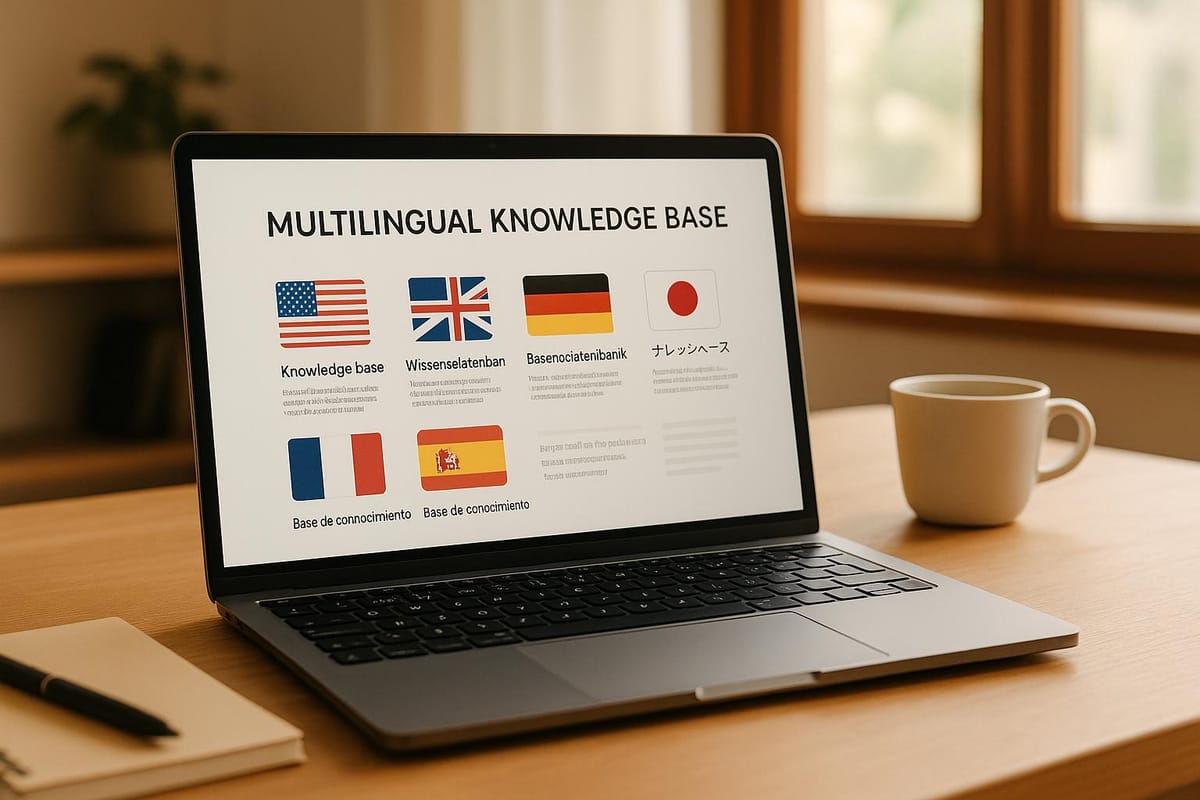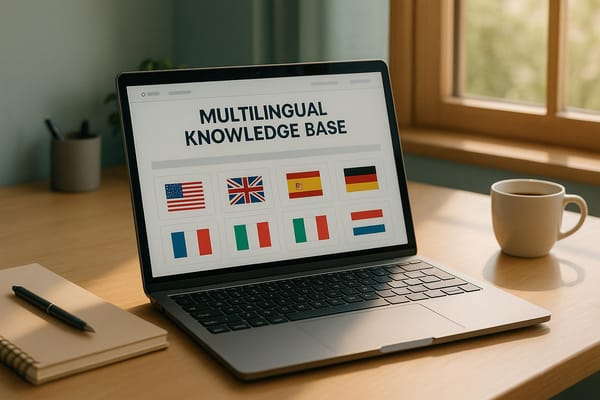Why Multilingual Knowledge Bases Are a Game-Changer for Global E-Commerce
Explore how multilingual knowledge bases drive global e-commerce success by enhancing customer satisfaction, sales, and loyalty.

Did you know 76% of folks who buy things online like to see product info in their own language, and 40% will go away if it's not there? For shops that sell worldwide, not having many languages can mean they lose customers and money. AI-powered ways of sharing info that understand many languages help with this. They offer right, local help in lots of languages - all day, every day. Here's why this is key:
- More Sales: Shops that help people in many languages can make up to 200% more money in worldwide markets.
- Less Cost: Self-help in one's own language cuts the need for help by up to 40%.
- More Loyalty: 74% of people come back to brands that use their language.
- Quick Growth: AI tools make fast, right-for-the-place translations easy to do.
Why Online Shops Need Many Languages
People buy more if they can read about a product in their own tongue. About 75% of buyers like to shop where details are in their native language. This isn't just a bonus - it's a must that brings in more money. AI tools are helping a lot here. They make content that fits many languages, letting businesses reach new buyers all over.
Taking Down Language Walls to Get More Buyers
Language issues can stop firms from reaching global users well. When buyers find it hard to get what product info means, or the return rules, they might go to other shops that talk their language. In fact, 13% of shoppers will switch to a site that helps them in their own tongue. This trust is key for buying online.
A big U.S. shop started a Spanish site with help that speaks Spanish. The results? These buyers stayed longer, spending went up by 18%, and they came back more, up by 25%.
The chance for selling across borders is huge. Businesses selling abroad can earn up to 200% more money compared to just at home. But, going wide without language help can lead to 30% higher costs to get new buyers and 25% less of them sticking around.
Better Buying Feel with Home Language Info
Having info in a buyer's own language makes them happier. Nine out of ten web users choose sites in their language, and they're 20% more pleased when helped in their tongue.
For instance, a financial group serving Chinese-Americans added multilingual help on calls, videos, and face-to-face, even translating important papers. The result was great: more Chinese speakers stayed as clients, up by 35%, and more referred others. The money benefits are big - buyers helped in their language spend up to 10% more each time.
Winning More with Many Languages
Besides making customers happier, speaking many languages helps firms stand out worldwide. Companies good at this have 30% lower costs to get new buyers and 25% more of them stay. This means stronger loyalty: 74% of buyers come back to shop more if the shop helps in their native language, and 94% feel more loyal to brands that give local content.
Think of a new online shop that worked with a multilingual team to help buyers 24/7 in five languages. Within three months, they saw quicker answers and sells in non-English markets went up by 18%. Also, brands that translate their main pages and ads see up to a 20% rise in sales, with better search spots and more buyer interest.
A U.S. phone company had a lot of Spanish speakers leaving them. To fix this, they set up help in Spanish with agents who speak it first and quick help from interpreters. What happened? A 22% fall in how many left within six months, and people liked their service way more.
These stories show that help in many languages is not just to make talking easier - it's about growing and staying on top in markets with lots of competition.
How AI Helps with Many-Language Knowledge
AI is changing how online shops make and handle content in many languages. With this tech, firms can now give out right, local stuff in just minutes, meeting the big need for quick, own-language help from worldwide buyers.
AI Translation for Quick, Right Stuff
Today's AI translation does more than just change words. Using a deep learning system, it keeps the full meaning, sticks to the brand's style, and stays true. It even uses past translations and works with partly done texts without a hitch.
The proof is there. Tests show that 72.4% of people are more likely to buy if the product details are in their own language. Also, 56.2% of buyers care more about product info in their language than cheap prices. eBay’s AI system is a top show of this - it pushed up exports by 17.5% and raised money by 13.1% from buyers who speak other languages. Buyers came from places like Latin America, Asia, and Europe, and the system’s word rightness got better by an estimated 10% compared to past ways.
AI text tools can also be set for certain fields, terms, and style choices. A mix way, where AI does the first translations then people make it exact, makes sure it’s both fast and sharp.
Making Stuff for Local People
AI doesn’t just translate - it changes content to hit home with local markets. By looking at big data sets, AI finds out customer trends and groups, making super-custom content. This means adjusting words, cultural points, and local trends to better reach people. Firms that use this custom tech often sell 30% more than others.
Big names are already using this edge. Coca-Cola made area-based ads during the FIFA World Cup, checking local feelings and adding focused pictures to grow its brand. In the same way, Netflix uses AI to change shows based on what local people watch, which has greatly upped sub numbers worldwide.
AI also gives firms a boost in local SEO by spotting hot search words. Top tools make sure that local sayings are right and practical stuff like money, measures, and area likes fit right in.
"Global brands are going full chameleon - blending big-picture strategy with local flavor. McDonald's tweaks menus, Netflix customizes content and Nike reps local athletes. The secret? Hyper-local data, cultural nuance and smart AI-driven insights. The playbook: Think global, act local and never assume one-size-fits-all (because it doesn't - even in sweatpants)."
- Evan White, CMO at ERIN
Live Changes in All Tongues
AI does more than switch and fix words - it changes content in many languages right as it happens. What once needed slow, hands-on fixes now gets done by itself. Today's AI tools get the set-up, see cultural hints, and change all versions at the same time. These systems also check live market data to keep updates on point.
Look at Vista, for instance. Back in February 2025, this design and ad help for small firms, working in 13 tongues over 23 places, brought Phrase into its work with Contentful. This mix made it simple to handle and watch changes in words.
"Instead of spending a lot of time setting things up, they only had to click one button, add their log-in info, and connect to Contentful."
In a lot of ways, Snyk, which works on keeping devs safe, made French, Japanese, and German sites in just two months with the help aid of the Phrase Contentful plugin. Being able to change content fast is key when lots of people are buying things. For example, in the winter holiday time of 2024, people in the U.S. spent 8.7% more online, hitting around $241.4 billion from the start of November to the end of December. Shops with AI-driven systems saw a huge jump in site visits - 1,300% more. By updating info fast on help pages, chat, and other key spots, firms make sure buyers get the right details in the language they know best.
How to Make a Knowledge Base in Many Languages That Grows
To help your brand reach more of the world, your knowledge base in many languages must grow as your business does. This calls for smart choices based on data, smooth steps for translating, and easy hook-up with your current help systems.
Picking Languages from Your Customer Data
Did you know that just 20% of people around the world talk in English? This opens a big chance to get into new markets by giving help in other languages. First, look at your customer data. Check out site numbers, help calls, and chats on social media to find out what languages your users prefer.
Here's why this is key: 74% of users will likely stay with a brand that talks to them in their own language. Asking your users what languages they like can also give you good info. For example, one SaaS company that worked in Latin America and Asia saw a 20% jump in happy customers after they made a knowledge base in 12 languages for those places.
Aim at the top languages from your data and where you plan to grow. If many help calls are in other languages than English, make those a priority. Keep a close watch on these trends since customer groups can change.
After picking the main languages, use AI and people to make sure your content is good.
Using AI and People for Quality
Mixing AI's speed with people's eye for details is how you get top-notch content in many languages. A 2024 McKinsey study found that 34% of AI use in firms is for marketing and sales. This tech can change how you translate.
AI tools can translate way faster - 200 times quicker - and cut down editing by 67% when compared to old ways. Machine Translation Post-Editing (MTPE) makes translators 60% more productive while keeping quality high. Here's how it works: AI does the first draft, then people tweak words, style, and local details to fit your brand's tone. For instance, Lokalise AI tests show that 80% of translations are right the first time.
To keep getting better, set up systems where people fine-tune AI translations and those fixes help the AI learn.
After your translations are ready, the next step is to connect your knowledge base in many languages to your systems.
Linking Your Knowledge Base with Current Systems
Linking is key to keep everything working well. Without it, your multilingual knowledge base might just complicate things.
Pick customer help software that can find out a customer’s language and send their issues to the right team. For instance, your help desk should sort tickets by language, cutting waits and mix-ups. Set rules for auto replies in the right language and for raising big issues when needed.
Translation Management Systems (TMS) are a key part of the mix. These tools work with your Content Management Systems (CMS) and Customer Relationship Management (CRM) setups, making sure that language likes are the same at every place a customer can reach. One SaaS company used these links to help people from 12 places fast and clear.
Also, team tools with quick translation can let your group talk well in many tongues.
| Tool Type | Examples (Simple) | Use Case |
|---|---|---|
| Language Tools | AI based language tools | Make and change content fast |
| Help Desk Tools | Help desk routing systems | Handle and send help requests |
| Info Base Platforms | Tailored answer setups | Create local FAQs and how-to guides |
| Buyer Stats Tools | Area-based stats tools | See how buyers act in each area |
The setup may look hard, but the gains are clear. Sixty-eight out of a hundred customers want help in their own language. Companies that do this see more happy customers, less cost for support, and more money from global markets.
Job Wins from Many-Language Help Files
Many-language help files change the game for jobs, cutting help costs, making search ranks better, and pushing up money made all over the world.
Cutting Help Costs and How Many Ask For Help
When buyers can help themselves in their own words, they are much less likely to ask for help with easy things. This means less work for help teams, giving them time to work on harder stuff.
Look at OLX, the well-known ads site, for instance. By putting in market-specific help pieces in their files, they cut down the number of help asks by 40% all over the world. In the same way, Mexico's INAI group started a many-language talking help tool in both English and Spanish, making buyer happiness go up by 45%. It's important to say that jobs without many-language help might lose up to 75% of B2B and B2C buyers.
"Having one source of truth for knowledge is a scalable, time-saving solution that fosters a more accurate and consistent experience for your multilingual customers." - Tara Ramroop, Content Marketing Manager
By cutting down simple questions, firms not just save money but also let their staff deal with bigger problems - while also making their digital presence stronger.
Making Search Scores Better with Local Content
Local content helps not just buyers - it’s also key for search engine growth (SEO). Writing help articles in home languages with specific local words really ups search ranks where customers look for help.
The facts are clear: 73% of shoppers worldwide like product reviews in their own language when buying online, and 65% prefer reading in their language. By using local word plans, firms can up their web visits, make their presence better, and grow into new areas.
Up Money Making by Going Global
Breaking language blocks builds trust with shoppers, leading to more connections and fewer lost sales. For instance, a U.S. online shop grew into Latin America by translating its product info, help stuff, and emails into Spanish and Portuguese. The end? A 38% rise in local sales, a 22% fall in lost sales, and a 40% jump in happy customers.
ASOS, from the U.K., makes over half its $1.8 billion from buyers outside. Their way? Making 60,000 pieces of fashion content in many languages each month. Firms good at many languages are also 1.5 times more likely to see money growth. A top example is Martin Engineering, which got its first global customer in just four hours after starting their multilingual setup.
Ending: Making Global Online Sales Big with Help in Many Tongues
Many tongue help desks change how firms fix world client support and grow wide. Firms that put help in many tongues first see clear bettering in big work parts.
Think on this: 76% of people like to buy in the tongue they know best, and about 70% will go to another if they don't get help in their own tongue. Salvador Ordorica, big boss of The Spanish Group LLC, says it just right:
"When users are served in their language, there are fewer misunderstandings, and problem resolution becomes more effective because both parties feel confident in their communication. Quick and precise attention to issues improves customer satisfaction."
Happy customers don't just stick around - they also cut costs. By letting them help themselves in many languages, firms can take on fewer support calls and still touch more people. In truth, 13% of buyers go for shops that give local feels.
HelpJam’s AI tools push this idea even more. This tech makes many-language content on its own. No need for pricey teams or hard translation work. It changes and adapts text in real time, making sure it's right and clicks with many cultures.
The risk is big: 29% of firms miss out on deals by not having help in many tongues. With HelpJam’s vast, many-language help base, online shops can step into new places sure that their users get the same great help, near or far, no matter the language.
To win in world-wide e-commerce, great multi-language help is key. Firms using HelpJam’s smart tech not only save money but also grow trust and loyalty wide and far.
FAQs
How do many-language help spots make buyers stick to global online shops?
When shops offer support in many languages, they make shopping feel more personal and welcoming. Buyers feel valued and seen when they can get help and info in their tongue. This link makes trust and ties them closer to the brand.
Help spots in many tongues also let buyers fix their issues on their own fast. Fast fixes make them happy and they might buy more. By giving help in many languages, companies show true care for all their buyers around the world. This builds strong and long ties and deep links with customers.
How does AI help with many-language translations for world-wide web shops?
AI and Its Role in Changing Many-Language Translations in Online Shopping
AI has changed the game for translating many languages in world-wide web shops, making it quick, right on point, and easy to handle. By using AI to do translations, shops can keep the same message in all languages with no trouble. Also, AI tools are clever enough to handle culture-based details, making sure the text seems real and gets close to different people.
These tools use big piles of data and smart steps in math to come up with translations that are not just right but also fit the setting well. This kind of sharp work makes customers more happy and cuts down the time and cost of doing translations by hand. For web shops that want to sell to more countries, AI is a smart, useful way to reach people all over the world.
How can companies pick the right languages for a multilingual knowledge base?
To choose the right languages for your knowledge base, start by looking at where your customers are and could be. Look into who your customers are, what languages they speak, and how often they need help in different languages. For example, languages like Spanish, Mandarin, and Hindi are getting more important around the world because a lot of people speak them.
It’s key to think about local ways and what people expect to connect well with your audience. This not only makes customers happier but also helps to build trust and loyalty, making it easier for your business to grow in other countries.





